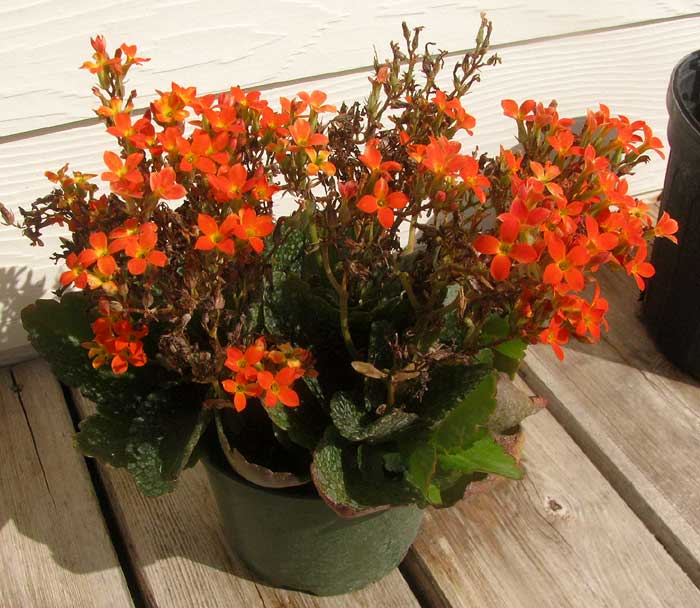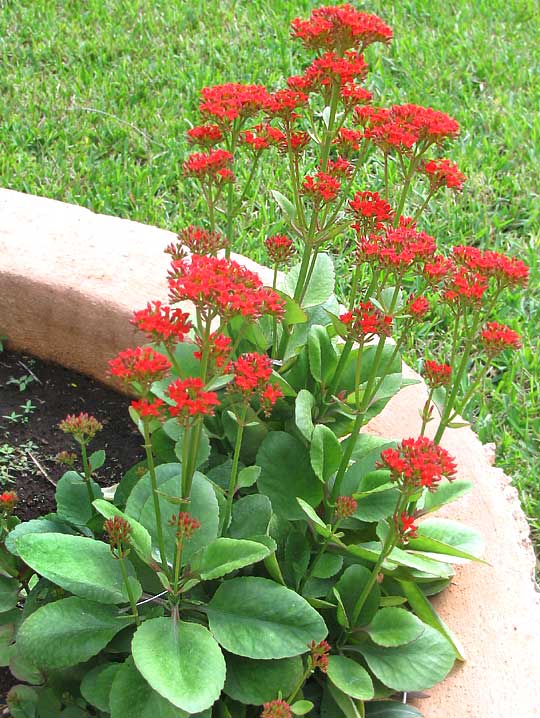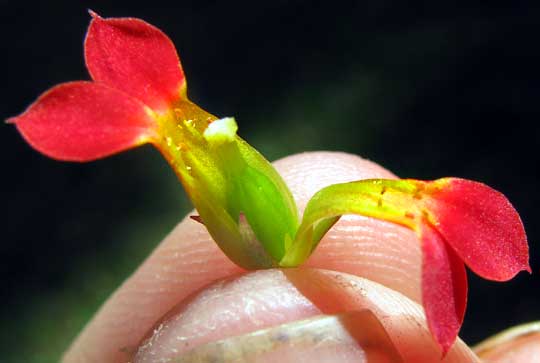Excerpts from Jim Conrad's
Naturalist Newsletter

from the July 13, 2014 Newsletter issued from the Frio Canyon Nature Education Center in the valley of the Dry Frio River in northern Uvalde County, southwestern Texas, on the southern border of the Edwards Plateau; elevation ~1750m (~5750 ft); N29.62°, W99.86°; USA
FLAMING KATY
Back in the Yucatan one of the favorite ornamental plants in tourist areas was a red-flowered, succulent or fleshy-leaved plant generally known in books as Flaming Katy. It's Kalanchoe blossfeldiana, and it's shown gracing a large pot on the Hacienda Chichén grounds below, in the next section.
Scarlet blossoms atop tallish peduncles held well above the plant's thick, oval leaves -- which is how those in the Yucatan presented themselves -- is what I have fixed in my head that a Flaming Katy looks like. Therefore, I wasn't sure whether a similar but much shorter and more compact plant on my neighbor Phred's porch also was a Flaming Katy. That plant is shown above.
A broken apart flower showing a cluster of green pistils inside the blossom instead of the single pistil found in most similar flowers is shown below:

To figure out if Phred's short plant was the same as the Hacienda's tall ones, I had to "do the botany."
So, whenever you have a plant with succulent leaves and four or five pistils in a flower, just think "Stonecrop Family, Crassulaceae," because those are easy-to-see field marks of that family, and of course Flaming Katy belongs to it.
Within the Stonecrop Family several genera produce important garden plants, especially in dry areas. In that family, if you have a plant whose flowers bear twice as many stamens as petals, the petals unite at their bases to form corolla tubes, and the corolla bears four (not five) petals or lobes, then you have the genus Kalanchoe. In our flower picture we have four stamens and two corolla lobes, but we're looking at only half of a corolla. Thus the flower's eight stamens and yellow corolla tube definitely make it a Kalanchoe. Both Phred's porch plant and the plants in the Yucatan meet those criteria, so we know they're both members of Kalanchoe.
Within the genus Kalanchoe, about half of the several species seen in cultivation have inflated calyxes, a little like balloons surrounding the pistils. Our plants' calyxes aren't balloon-like -- and neither were they on flowers of Yucatan plants -- so we cut down on the possibilities right there. At this point in the identification process, if the flowers are red instead of white, yellow or reddish-orange, and if they're no wider than half an inch across, then we have the Flaming Katy. And both Phred's plant and those at the Hacienda satisfy that description. Therefore, despite the big difference in how they flowers are disposed, they're the same plant, KALANCHOE BLOSSFELDIANA, a native of Madagascar.
Looking into why Phred's plants are so short and compact while the Hacienda's were tall and open, I find that during the history of Flaming Katy breeding, a lot of effort has gone into creating short, compact plants like Phred's. I'm guessing that the Hacienda's plants are from stock introduced into the area long before many of the newer cultivars were developed.
Plant providers hustle to keep their Flaming Katy's short and compact. Auburn University produces a webpage with detailed information on how to accomplish this at http://www.ag.auburn.edu/hort/landscape/Kalanchoe.htm.
The main way to guarantee that plants stay short and compact is to buy from specialists propagators known to have short, compact stock. Since the plants' leaves grow closer at branch tips, sometimes these tips are snipped off, rooted and sold in pots. Pinching of stem tips can make plants grow denser. And many greenhouse operators who sell to the public use chemical growth retardants, especially one called B-Nine, to keep potted plants short and dense.
Poor Flaming Katy. I'm glad the ones in the Yucatan are allowed to grow as they want.
from the January 24, 2010 Newsletter issued from Hacienda Chichen Resort beside Chichén Itzá ruins, central Yucatán, MÉXICO
FLAMING KATYS
A commonly potted houseplant up North planted outside here and now flowering very prettily is a red-flowered succulent going by such inspired names as Flaming Katy, Madagascar Widow's-thrill, Christmas Kalanchoe and Florist Kalanchoe. It's KALANCHOE BLOSSFELDIANA, a native of Madagascar, shown below:

Flaming Katys are members of the Stonecrop Family, the Crassulaceae. For admirers of "succulents" -- plants with fleshy parts well adapted for preserving water --the Stonecrop Family is important, for it embraces many potted plants as well as plants used in rock gardens that receive little or very intermittent watering.
An interesting feature of the Stonecrop Family is that its 25 or so genera fall neatly into two groups: Those whose stamen number equals the number of corolla lobes or petals, and those whose stamens are twice the number. Kalenchoe falls into the group with stamens twice as many as the petals, as you can see yourself below:

Flaming Katys are rated as requiring temperatures of at least 50ºF (10ºC), though they can stand brief periods of lower temperatures, as indicated by the fact that in southernmost Florida they've been noted as escaping from cultivation.